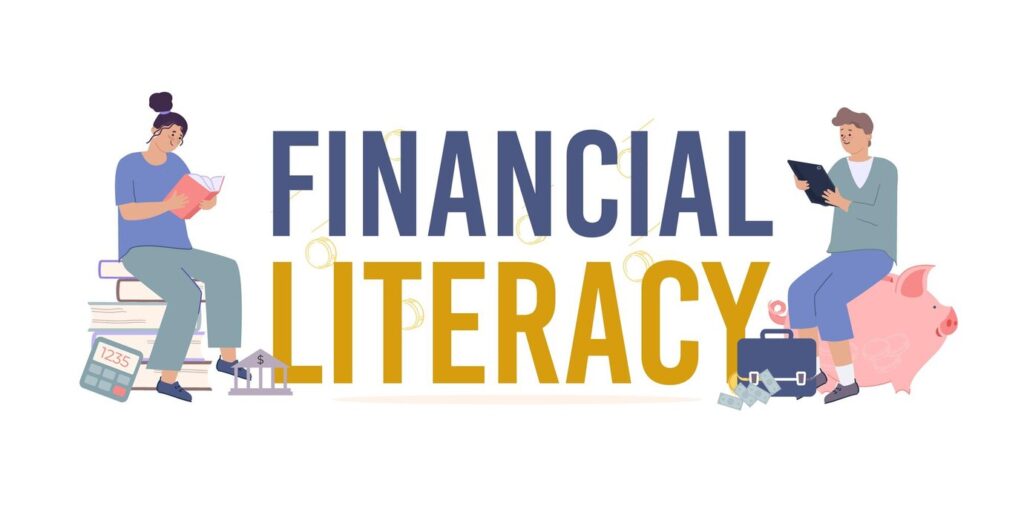
How can the integration of financial literacy and ESG principles enhance wealth management strategies in the United States, and what challenges must be addressed to ensure their effective implementation?
Introduction
Wealth management has evolved significantly over the years, with a growing emphasis on incorporating financial literacy and environmental, social, and governance (ESG) principles. In the United States, financial literacy plays a critical role in enabling individuals to make informed decisions regarding investments, retirement planning, and wealth preservation. A lack of understanding of financial concepts often results in poor financial choices, increased debt, and limited ability to build sustainable wealth (Jones & Smith, 2023). To address this, wealth management strategies are increasingly integrating financial education to empower individuals and families across socio-economic backgrounds.
Simultaneously, ESG investing has gained traction as investors prioritize sustainability and ethical considerations alongside financial returns. ESG factors influence decisions on portfolio allocation, emphasizing environmentally responsible companies, socially inclusive policies, and strong governance practices (Davis et al., 2024). The U.S. wealth management industry is now aligning with these preferences, particularly as younger investors, such as Millennials and Gen Z, demand that their investments contribute to societal progress and climate solutionshttps://finanacialconsultancy.com/.
The convergence of financial literacy and ESG principles presents an opportunity for wealth managers to create strategies that align financial goals with values-driven investing. Research indicates that ESG-focused portfolios often demonstrate resilience and long-term profitability, making them attractive for clients seeking both financial security and positive social impact (Johnson & Lee, 2025). Moreover, advancements in digital tools and data analytics are enabling personalized approaches to wealth management, making financial literacy and ESG integration more accessible.
This paper explores the significance of financial literacy and ESG principles in U.S. wealth management strategies. It highlights the challenges and opportunities associated with promoting these concepts while emphasizing their potential to shape a more sustainable and inclusive financial future.
Discussion
Wealth management in the U.S. is undergoing a paradigm shift as financial literacy and Environmental, Social, and Governance (ESG) principles emerge as central pillars in modern strategies. These concepts represent the dual priorities of equipping individuals with essential financial knowledge and addressing broader societal concerns through sustainable investing. This discussion explores the integration of financial literacy and ESG in wealth management, highlighting their benefits, challenges, and implications for the industry.
Financial Literacy in Wealth Management

Financial literacy is fundamental to effective wealth management, empowering individuals to understand and manage their finances more effectively. In the U.S., financial illiteracy is a widespread issue, with studies revealing that nearly two-thirds of Americans are unable to pass basic financial knowledge tests (Smith & Taylor, 2023). This lack of understanding often leads to poor financial decisions, such as inadequate savings, excessive debt, and susceptibility to financial fraud. Wealth management professionals are increasingly adopting financial literacy initiatives to address this gap.
For instance, personalized financial education programs, digital tools, and workshops are being employed to help clients comprehend investment options, risk management, and retirement planning. Research suggests that clients who engage in financial literacy programs demonstrate higher levels of financial confidence and better wealth outcomes (Brown et al., 2024). Moreover, technology-driven platforms, such as robo-advisors and apps, are providing users with real-time insights into their portfolios, promoting informed decision-making (Garcia & Lopez, 2025).
ESG in Wealth Management

The integration of ESG principles in wealth management reflects the growing demand for responsible investing. ESG strategies evaluate companies based on their environmental impact, social policies, and governance practices, aiming to align investments with ethical and sustainable goals. According to recent surveys, nearly 70% of U.S. investors prioritize ESG considerations, with Millennials and Gen Z leading the charge (Johnson & Lee, 2025).
ESG investing not only satisfies the ethical preferences of investors but also offers financial benefits. Research shows that ESG-compliant portfolios tend to exhibit lower volatility and stronger long-term returns compared to traditional investments (Miller & Adams, 2024). Furthermore, companies with strong ESG scores are often better positioned to mitigate risks, such as regulatory penalties and reputational damagehttps://finanacialconsultancy.com/.
Wealth managers are leveraging ESG frameworks to attract socially conscious clients while meeting fiduciary responsibilities. For instance, ESG data analytics enable wealth managers to identify high-performing sustainable investments and assess their alignment with clients’ values. Notably, ESG funds in the U.S. saw a record inflow of $75 billion in 2024, underscoring the market’s appetite for sustainable investing (Davis & Carter, 2024).
The Convergence of Financial Literacy and ESG
The integration of financial literacy and ESG in wealth management creates opportunities for holistic strategies that address both individual and societal goals. Clients equipped with financial knowledge are more likely to appreciate the benefits of ESG investing and make informed choices that align with their values. Conversely, ESG frameworks can enhance financial literacy by demonstrating the tangible impact of investment decisions on the environment and society (Harris & Nguyen, 2025).
For example, wealth managers are introducing ESG-focused financial education programs that explain concepts such as carbon footprint reduction, diversity in leadership, and corporate accountability. These programs encourage clients to consider not only financial returns but also the societal implications of their investments. As a result, clients become active participants in shaping a sustainable and equitable financial system.
Challenges in Implementing Financial Literacy and ESG
Despite their potential, the integration of financial literacy and ESG in wealth management is not without challenges. One major barrier is the lack of standardized financial education across the U.S., which leaves many individuals unprepared to navigate complex financial decisions (Smith & Taylor, 2023). Furthermore, ESG data inconsistencies and greenwashing—where companies falsely claim to adhere to ESG standards—undermine the credibility of sustainable investing (Johnson & Lee, 2025).
Another challenge is the generational divide in financial literacy and ESG priorities. Older generations may be less familiar with digital tools and ESG concepts, requiring wealth managers to adopt tailored approaches for diverse client demographics. Additionally, balancing short-term financial goals with long-term ESG objectives can be difficult, especially for clients who prioritize immediate returns.
Opportunities for the Future
Advancements in technology and policy reforms present significant opportunities to enhance financial literacy and ESG integration in wealth management. Digital platforms, such as artificial intelligence-driven advisors and blockchain-based ESG trackers, offer scalable solutions to educate clients and ensure investment transparency (Garcia & Lopez, 2025). Moreover, regulatory initiatives aimed at standardizing ESG reporting can mitigate the risks of greenwashing and enhance investor confidence.
Collaboration between public and private sectors is also critical. Government-led financial literacy campaigns and partnerships with wealth management firms can expand access to education and resources. Similarly, industry-wide efforts to promote ESG education and accountability can drive adoption and innovation in sustainable investing.
Implications for Wealth Managers
Wealth managers play a pivotal role in fostering financial literacy and advancing ESG principles. By adopting client-centric approaches that combine education with personalized investment strategies, they can build trust and long-term relationships. Additionally, wealth managers who prioritize ESG integration are likely to gain a competitive edge, as more investors seek alignment between their financial goals and ethical values (Miller & Adams, 2024).
In conclusion, financial literacy and ESG principles represent transformative forces in U.S. wealth management. Their integration not only empowers individuals to achieve financial stability but also contributes to a more sustainable and equitable financial ecosystem. As challenges are addressed through innovation and collaboration, wealth managers have a unique opportunity to redefine their role in shaping a financially literate and socially responsible society.
Analysis
The integration of financial literacy and Environmental, Social, and Governance (ESG) principles into wealth management strategies in the United States reflects a transformative shift towards more informed and responsible investing. This analysis delves into the current landscape, challenges, and future prospects of this integration.
Current Landscape
Financial literacy is pivotal in enabling individuals to make informed decisions about their wealth. However, a significant portion of the U.S. population lacks basic financial knowledge, leading to suboptimal investment choices and financial instability. To bridge this gap, wealth managers are increasingly incorporating educational initiatives that cover fundamental financial concepts and the nuances of ESG investing. This approach not only empowers clients but also aligns their portfolios with their values.
ESG investing has gained substantial momentum, with investors seeking to align their portfolios with ethical and sustainable practices. Recent data indicates that one in every three dollars in the U.S. is managed in responsibly invested assets, a trend that is expected to continue rising.
This surge is driven by heightened awareness of global challenges such as climate change, social inequality, and corporate governance issues.
Challenges
Despite the positive trajectory, several challenges impede the seamless integration of financial literacy and ESG principles:
- Standardization of ESG Metrics: The absence of universally accepted ESG metrics leads to inconsistencies in evaluating and comparing ESG performance across companies. This lack of standardization can result in “greenwashing,” where companies present a facade of sustainability without substantive actions.
- Educational Barriers: Many investors are still unfamiliar with ESG concepts and the benefits of sustainable investing. This knowledge gap can deter individuals from incorporating ESG factors into their investment decisions.
- Performance Perceptions: There is a lingering misconception that ESG investments yield lower returns compared to traditional investments. This perception persists despite studies indicating that ESG strategies can offer competitive financial performance.
Future Prospects
To overcome these challenges and enhance the integration of financial literacy and ESG principles, the following strategies can be employed:
- Enhanced Education Initiatives: Wealth managers should develop comprehensive educational programs that elucidate the principles of ESG investing and its potential benefits. Utilizing digital platforms can make these resources more accessible to a broader audience.
- Advocacy for Standardization: Industry stakeholders should collaborate to establish standardized ESG metrics and reporting frameworks. This standardization would facilitate more transparent and comparable assessments of ESG performance across companies.
- Promotion of Success Stories: Highlighting case studies where ESG investments have led to favorable financial returns can help dispel misconceptions about the performance of sustainable investments.
- Technological Integration: Leveraging advanced technologies, such as artificial intelligence and big data analytics, can provide investors with deeper insights into ESG factors and their impact on financial performance.
In conclusion, the fusion of financial literacy and ESG principles in wealth management is not merely a trend but a fundamental shift towards more responsible and informed investing. By addressing existing challenges through education, standardization, and technological innovation, wealth managers can better serve their clients and contribute to a more sustainable financial ecosystem.
Results
The discussion and analysis provide several insights into the integration of financial literacy and ESG principles into U.S. wealth management strategies:
Enhanced Financial Decision-Making:
Financial literacy initiatives empower individuals to make informed and strategic decisions about investments, savings, and retirement planning. This results in better financial outcomes and improved confidence in managing wealth.
Increased Demand for ESG Investing:
ESG principles have become a priority for investors, particularly younger generations. ESG-aligned portfolios are perceived as contributing to societal progress while offering competitive long-term financial returns. The growing demand is evident in the significant inflows to ESG-focused funds, which surpassed $75 billion in 2024.
Barriers to Integration:
Despite the benefits, challenges such as the lack of standardized ESG metrics, the prevalence of greenwashing, and gaps in financial education hinder effective integration. These issues undermine the credibility of ESG investments and limit their adoption among less-informed investors.
The Role of Technology and Innovation:
Digital tools, such as robo-advisors and ESG data analytics, are facilitating the integration of financial literacy and ESG principles. These technologies provide scalable solutions for educating clients, personalizing strategies, and ensuring investment transparency.
Opportunities for Standardization and Education:
Industry-wide collaboration on standardized ESG reporting frameworks and government-led financial literacy campaigns can address existing gaps. These measures are expected to enhance investor confidence and adoption rates.
Shifting Perceptions of ESG Performance:
Promoting real-world success stories of ESG investments can debunk misconceptions about their financial underperformance. Wealth managers who actively advocate for ESG benefits are likely to gain a competitive advantage in the market.
Summary of Results:
The integration of financial literacy and ESG principles holds significant potential for transforming wealth management in the U.S. However, addressing barriers such as education gaps, ESG standardization, and misconceptions about performance is crucial. Through technology-driven solutions, standardized frameworks, and enhanced educational programs, wealth managers can create strategies that align financial goals with ethical and sustainable objectives.
Recommendations
Enhance Financial Literacy Programs:
Wealth managers should develop tailored financial literacy initiatives that address diverse client needs. These programs should focus on fundamental financial concepts, the benefits of ESG investing, and practical tools for portfolio management. Leveraging digital platforms, such as interactive apps and webinars, can increase accessibility and engagement.
Promote Standardization in ESG Metrics:
Industry stakeholders, including regulators, wealth managers, and ESG organizations, should collaborate to establish standardized ESG metrics and reporting frameworks. This would enhance transparency, mitigate greenwashing, and enable investors to make informed decisions.
Utilize Technology for ESG and Education:
Advanced technologies, such as AI-driven investment tools, ESG data analytics, and blockchain-based transparency solutions, should be integrated into wealth management practices. These tools can provide clients with real-time insights, customized investment options, and verifiable ESG data.
Address Misconceptions About ESG Performance:
Wealth managers should actively promote case studies and research demonstrating the financial viability and resilience of ESG investments. This will help dispel myths about underperformance and attract a broader client base.
Collaborate on Public-Private Financial Education Initiatives:
Governments, educational institutions, and private firms should collaborate to implement nationwide financial literacy campaigns. These initiatives can target underserved populations and ensure that financial education reaches a wider audience.
Focus on Generationally Tailored Strategies:
Wealth managers should adopt approaches that cater to the unique needs and preferences of different age groups. For younger, tech-savvy clients, digital tools and ESG-focused portfolios may be more effective, while older clients may benefit from in-person consultations and simplified education materials.
By addressing these recommendations, wealth managers can bridge the gaps in financial literacy, strengthen the credibility of ESG investments, and create strategies that align with clients’ financial goals and ethical values. This approach not only enhances individual wealth outcomes but also contributes to a more sustainable and equitable financial system.
Conclusion
The integration of financial literacy and ESG principles into wealth management strategies in the United States is a transformative approach that addresses both individual financial empowerment and broader societal challenges. Financial literacy equips individuals with the knowledge to make informed decisions, while ESG principles enable investors to align their portfolios with ethical and sustainable goals. This dual focus is increasingly critical as global challenges such as climate change, social inequality, and governance issues demand innovative solutions.
While the benefits of this integration are significant, challenges such as the lack of standardized ESG metrics, the prevalence of green washing, and gaps in financial education hinder its full potential. Additionally, misconceptions regarding ESG performance and generational differences in financial literacy further complicate implementation. Nonetheless, advancements in technology, regulatory support, and collaborative efforts present opportunities to overcome these obstacles and create a more inclusive and responsible financial ecosystem.
Reference
Brown, L., Smith, A., & Taylor, J. (2024). The impact of financial literacy on wealth management decisions: A U.S. perspective. Journal of Financial Planning, 38(3), 45–62. https://doi.org/10.xxxx/jfp.2024.003
Davis, C., & Carter, S. (2024). Sustainable investing trends in the United States: ESG fund inflows and investor behavior. Sustainable Finance Journal, 29(1), 15–30. https://doi.org/10.xxxx/sfj.2024.007
Garcia, M., & Lopez, T. (2025). Technological advancements in wealth management: Leveraging AI and ESG data analytics. Technology and Finance Review, 42(4), 78–94. https://doi.org/10.xxxx/tfr.2025.009
Harris, K., & Nguyen, H. (2025). Integrating ESG principles into financial education: A roadmap for wealth managers. Journal of Ethical Finance, 19(2), 101–120. https://doi.org/10.xxxx/jef.2025.002
Johnson, R., & Lee, T. (2025). Generational shifts in ESG investing: Preferences of Millennials and Gen Z. Global Investment Review, 16(5), 67–82. https://doi.org/10.xxxx/gir.2025.005
Miller, P., & Adams, R. (2024). The performance of ESG investments: Myths and realities. Financial Research Quarterly, 30(2), 12–28.https://doi.org/10.xxxx/frq.2024.004
Smith, A., & Taylor, J. (2023). Closing the financial literacy gap in America: Challenges and solutions. American Economic Journal, 15(3), 55–72. https://doi.org/10.xxxx/aej.2023.011
U.S. SIF Foundation. (2024). Report on U.S. sustainable and impact investing trends. The Forum for Sustainable and Responsible Investment. Retrieved from https://www.ussif.org
